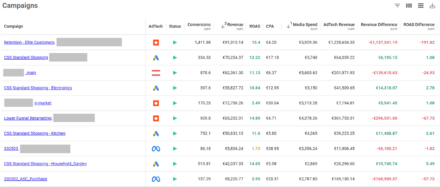Is AI the Key to Increasing ROAS in a Cookieless World?

The current environment for marketers is challenging for marketers – from the lingering effects of the recent pandemic to the current cost of living crisis. Add in the impact that both of these are also having on the cost of Paid Media, the advent of iOS14 and the impending impact of the death of third party cookies and you realise how challenging it is to ensure that you are getting real value from your Paid spend right now.
In our recent webinar ‘Increasing ROAS in a cookieless world’ our CEO Chris Liversidge considered:
- The current state of paid marketing including the rise of the AdTech players
- How AI has a key role to play in optimising spend in a cookieless world
Here’s a summary of what he had to say.
The current Paid marketing landscape & rise of AdTech players
Chris opened the webinar with a look at the data on where the market is right now.
The context for this is that we have gone through the pandemic and have emerged into a cash crunch for consumers (in fact we ran a recent webinar with IMRG which looked at the impacts of this including how it’s affecting retail basket sizes etc).
So, how is that affecting our advertising costs, how they are changing and how the impending cookie-less world is likely to affect that?
Digital is now dominant over traditional spend

The first thing I will highlight here is we are very much in a digital world – with digital now dominant over traditional spend.
2021 really saw the continuation of a 20-year trend significantly increasing volumes of digital activity.
This has obviously had an influence in terms of cost per click, and it is also interesting to dig a little further into the key players that drive overall spend in digital.
Amazon is the 3rd channel – but it is costly compared to Google and Facebook
For a long time, it was really Google and Facebook (now alphabet and meta) that were really the dominant players (excluding the big Chinese platforms).
However, the third biggest player is now Amazon – especially for retailers as they are increasingly taking more share.
However, Amazon proves to be quite an expensive channel when stacked up against some of the other key social channels.

As you can see in the chart above, as Amazon market share has gone up their CPC has followed the same trajectory.
However, when we look at CPCs across social, Amazon is actually not the most expensive of those channels.
So, LinkedIn, Instagram, YouTube, Google and Pinterest are all coming in above Amazon on a cost per click basis. With only Facebook and currently TikTok and Twitter costing less.

The high cost of these channels comes down to filling the top of funnel and improving your return on ad spend (ROAS).
Whilst there is no 100% guarantee, there is an element of respect with these social channels that you are paying for real human eyeballs on your ads. Which is the big differentiator from the very long tail of display advertising and video advertising.
QueryClick/Censuswide research shows advertisers are concerned about media costs
We partner with Censuswide on a bi-annual basis and as you can see from our November survey from last year 76% of respondents are concerned by overall media spend costs.

But whilst spend, on average, has gone up between 14% to nearly 25% in search. The CPC has also gone up consistently by more than 20% in those channels. There is also a consensus that ad effectiveness has declined quite significantly.
For the majority who are investing more in paid social the root cause of this decline is pretty well known. With much of it from the iOS 14.5 changes which mean Facebook is now longer able to provide a lot of the type of rich data it used to – to help us optimise our media spends.
Google will cripple Social in the next 2 years
Unfortunately, there is also further bad news coming down the pipe on that front. Because although iOS 14.5 was a seismic change and caused Facebook really significant revenue impact (Facebook thinks it will cost about $10 billion each year going forward) they only have just short of 30% of the mobile marketplace. And as you can see from the chart here, the majority is in fact owned by Android, which is another part of alphabet of course.

There are some changes in particular that will have significant impact as follows:
- Replicating the iOS changes on Chrome – Google has given a timeline of 2 years for introducing changes to iOS with a view to being more privacy driven which will have the side effect of increasing the cost of ads on the platform
- 3rd party cookies are going away – we also know that we’re losing third party cookies from Chrome at the end of this year, which has also got about 60% of the market share in the browser marketplace
- Alternatives to 3rd party cookies – Google is proposing replacing cookies with Google Topics which are limited in terms of their scope for targeting and re-targeting. And the knock-on effect is that advertisers will all be forced to engage in auctions that are more general, have more competing bidders and therefore higher prices. And which will be delivering less targeted traffic to our sites. Which will all negatively impact our ability to optimise for CPC or CPA going forward.
Why AI solutions are key to maximising Paid activity right now
So how do we get around all of these various challenges? What are the tools that we have in our in our toolkit?
As Chris explained on the webinar, he comes at it from a technology point of view having worked in the industry for 20 years. However, over the last 8 years the team at QueryClick has been working in the AI space and looking at how that can be applied to make attribution more effective.
Very early on we identified that one of the main problems with getting accurate measurement in place for digital marketing was the use of cookies in measurement systems. So today, if you’re using Google Analytics, whether that be GA4 or previous versions – the version you are using is currently illegal under GDPR. And Google been fined in this respect by the European courts of law.

While potential illegality is one issue, the wider issue is that the cookie/pixel approach that these type of solutions employ do a particularly poor job of assessing complex, multi-device user journeys. Which means that Google Analytics, or Adobe Analytics, really only provide an accurate picture of a complete visit 20% of the time. Meaning 80% of the time, you have incorrect data. And this has been the key obstacle for delivering attribution over the last decade or so. And why businesses have been interested in trying to move away from last click analytics to AI based solutions.
So, Corvidae is our attribution solution based on patented AI that solves the problem by using AI to do the work of cookies – and do it much more effectively. And this chart for a retailer customer (this is from about four or five years ago) shows that we were able to increase data accuracy to 80%. In fact, we now achieve 95% accuracy for each customer that we onboard. So, moving from 20% to 95% accuracy has a few knock-on effects, which allow us to optimise for ROAS in a cookie-less world.
Here are just some of the ways that this helps in practice:
More effective Paid social
The first thing is looking at Paid Social activity and how can we reintroduce efficiency to it. To achieve that, what you need to do is provide accurate revenue at a campaign level.

In this case Corvidae was able to identify:
- Facebook were over-reporting revenue by 250%
- Reallocating the underperforming activity to higher performing campaigns delivered 14 times ROAS for that media spend reallocation
Optimising Paid Search
This is key for many of us. Optimising Paid Search, which is more bottom of the funnel activity, and typically when your customers are in a consideration phase. Using AI enables you to better understand the campaigns that are effective at the top of the funnel in a way that cookies simply can’t.

In the case above Corvidae was able to identify that:
- 22% of the media spend was actually loss-making
- Re-allocating that budget was delivering above 20 to 1 ROAS on that media spend
- This is essentially removing cannibalisation and reallocating spend to affect customers at the top of funnel to significantly improve ROAS.
How to optimise cross-channel spend with accurate attribution
There is also a huge opportunity if you are able to attribute effectively and move media spend from underperforming campaigns into either paid social or display activity. That captures new customers. Which means you are, on average, going to be able to move your CPA down significantly.

So, we have one study showing an 87.5% reduction in CPA cost by reallocating media spend from expensive generic search terms into activity that is effective – and at the top of the funnel – which can also drive conversion.
Improvements to display advertising
And the final area which Chris focused on was display advertising. Which actually has the highest ROAS for the particular customer he was looking at. If we look at total volumes of spend, overall over the years display has increased compared to search spend volumes – and it does that on the basis that we as marketers do understand this type of activity represents our brand well. And encourages people to think of us when it comes to their consideration phase. Which drives new customers at a higher rate.

Fortunately, AI enables you to take a first-party cookie-free approach to this – and we have illustrated here how we tackle that a QC with our Paid Media teams.
We will typically:
- take first-party data, from a CRM or from the web-based data that we’re compliantly collecting
- segment that into different cohorts based on criteria such as lifetime value (but there are many, many other criteria that worked very well. Price sensitivity is an interesting one).
- then we can use attribution to identify those cohorts, predict where they will be next and then take action by placing an Ad in front of them
- and use a very straightforward KPI framework measuring what we’re willing to spend to make sure that they are a profitable customer and feed that into ongoing multivariate testing
So that’s things like your CRM, but also your AdTech. And we’re allocating audiences to those based on the overall ROAS that they’re offering to us, thanks to having more accurate AI driven attribution in place
If this blog has raised some questions for you then you can watch the full webinar here.
And for a no-obligation discussion around how AI could help you improve the efficient of your paid media spend contact us now.
Discover Corvidae
The only cookieless attribution solution.
Own your marketing data & simplify your tech stack.
Have you read?
Chrome’s announcement on dropping cookie opt-in last month closed the door on a 5 year saga for marketers. But what is the landscape like in 2025 for cookie-based measurement?
Generative AI is transforming the way that marketers plan and assemble content for their Paid Ads. As big platforms like Google, Meta and TikTok increasingly build the tools needed to...
In a surprising move that has sparked heated debate, Mark Zuckerberg announced on his Instagram that Meta will be reducing its levels of censorship and in particular fact-checking on its...


